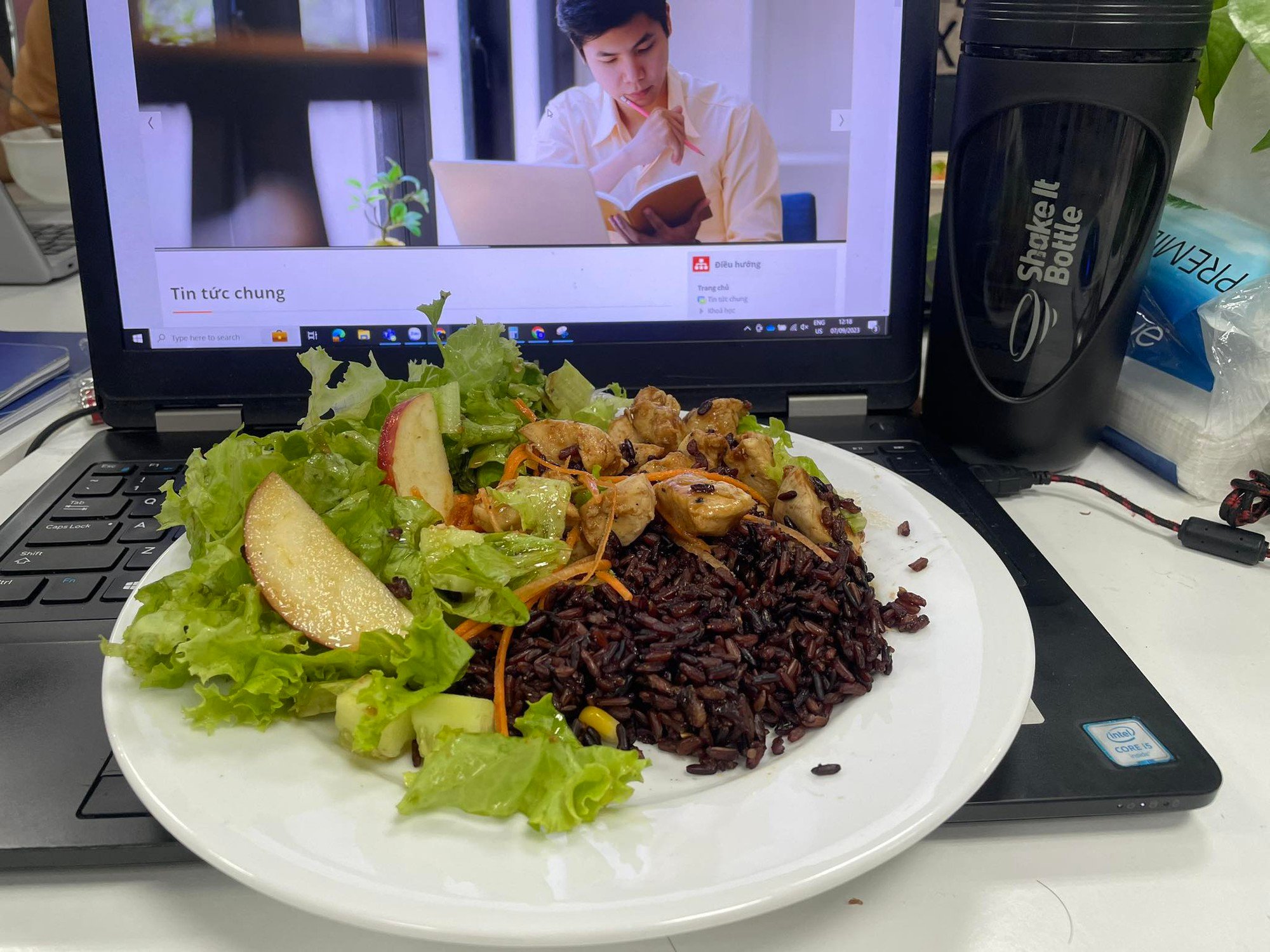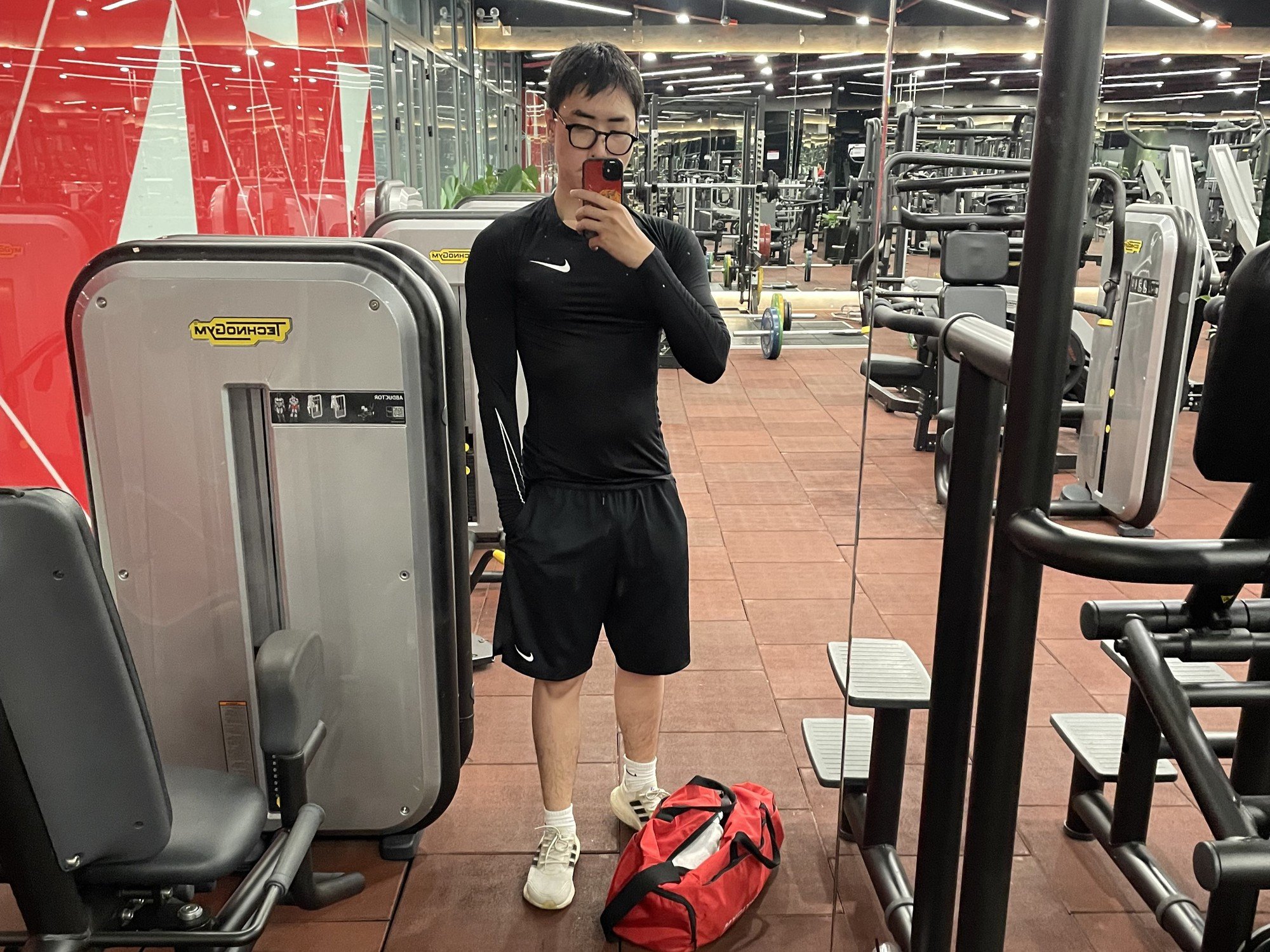
A healthy meal of brown rice, chicken and fruit salad
The working day starts at 9am, so from 5:30am, Nguyen Hua Quang Khoa, 23 years old, a former student of Ho Chi Minh City University of Economics , has to wake up to reheat rice and food cooked the day before. This is the "loop" that Khoa has maintained since the summer vacation of 10th grade until now to have a plump, healthy body, "no longer in the situation of being thin but having a lot of fat due to unreasonable eating".
How to gain muscle and lose fat?
Admitting himself as a "follower" of healthy eating, Khoa believes that depending on the goals of weight and body shape, students will build a suitable diet. In general, young people must supplement enough nutrients, diversify food groups, calculate the correct amount of calories needed based on age, weight, height, and at the same time limit eating too sweet, too salty, high in fat or using stimulants such as alcohol, beer, cigarettes... combined with exercise.
"The regimen I'm following is called 'gain muscle, lose fat', which means limiting the absorption of bad fats like animal fats and replacing them with good, easily metabolized fats like olive oil, cheese, butter; flexibly adding protein (chicken breast, beef, basa fish, salmon...), fiber, vitamins (vegetables, fruits, nuts) and low-calorie starch (vegetable noodles, brown rice, brown rice vermicelli...). To easily balance nutrition, I often make my own rice to bring with me," Khoa said.
While sharing about things to keep in mind in your diet, Khoa believes that all of these are secondary factors. The most important thing, according to him, is to have a long-term healthy eating plan for several months or years because its effectiveness only comes slowly, not overnight. "When I was a student, I often skipped meals or had a cup of milk tea or a loaf of bread. After just a few weeks, I felt sluggish, tired, and no longer had the same vitality as before," he confided.

According to Quang Khoa, the most important thing about a healthy diet is having a long-term plan and sticking to it.
Although he lost the freedom to "eat whatever he wants", Khoa affirmed that he "gained" more. In addition to his strong, masculine appearance that helped him become more confident, the 23-year-old man said that being healthy and mentally alert was the biggest "gift" he received when always facing "problems" that required creativity at work. "I even feel younger than before," Khoa said with a smile.
Five years younger than Khoa, Lam Vinh Hong, a freshman at RMIT University, also follows the "gain weight, lose fat" regimen like his senior and considers healthy eating habits a "compass" since grade 10. The male student believes in only drinking mineral water or drinks with little or no calories, and in his diet, he prioritizes white meat such as chicken, duck, fish and vegetables, and also adds protein from whey when working out at the gym.
"But there are also days when I 'let loose' with fast food, snacks... Building a clear discipline with 'rewards' after a certain period of time helps me have more motivation to exercise and stick to my eating habits. Because eating is like studying, it needs appropriate breaks," the male student commented, adding that because he wants to gain weight, he is applying a new diet of 4 meals a day.
After nearly 3 years of healthy eating, Hong commented that he was no longer as skinny as before. Moreover, the male student also had a clear improvement in health and energy, always maintaining a positive attitude towards the events happening around him. This "luggage" was the best preparation to help Hong feel more confident before starting his student life.

Vinh Hong has adopted a healthy diet since high school to always maintain a positive attitude.
"If you want to eat healthy, I believe the most important thing is to choose a starting point that is within your ability, just make the next day a little harder than the previous day. No one gets used to a high-intensity diet or super-heavy gym workout on the first day. But what we can all do is turn that eating and exercising into a habit," Hong said.
Need to understand correctly about 'eat clean'
Eating healthy is not only suitable for the goal of developing a body, but can also help young people stay in shape and improve their health, through some popular regimes such as eating clean. However, ensuring enough healthy meals every day is commented by students as "a feat and expensive", because they can only cook at home or buy at certain restaurants at quite high prices because this is not a very popular choice.
Specifically, Nguyen Trong Nghia, a student at the University of Social Sciences and Humanities in Ho Chi Minh City, recognized the "bright point" of "eat clean" after he applied it for a few months: it helps the body feel lighter, reduces acne on the face and helps sleep better. "This is a healthy diet with clean, organic ingredients, 'say no' to processed foods, foods with preservatives such as cold cuts, sausages, canned foods...", the male student said.
When he first started eating clean, Nghia shared that he had to "fight" his cravings because he had to divide his day into 5-6 small meals, each meal only allowing him to eat a small amount to keep his stomach full. This is even more inconvenient when students do not have many opportunities to eat during the day. Not to mention, if they do not have time to cook, they have to buy food from restaurants at prices ranging from 60,000 to more than 100,000 VND per meal.

"Eat clean" helps Trong Nghia maintain an attractive appearance to pursue his "side job" as a show host.
"Many people also equate eat clean with dieting to lose weight, but this is an incorrect view. 'Eat clean' aims to improve health and spirit through adding foods that are good for the body, and if you want to lose weight, you just need to 'burn' more calories than your body takes in by eating less combined with exercise," Nghia noted.
How to calculate calories correctly
According to students, there are two indicators that young people need to calculate in healthy diets: basal metabolic rate (BMR) and total daily energy expenditure (TDEE). Thus, to calculate the amount of calories needed to maintain weight, we apply the formula TDEE = BMR x R.
In which, BMR is calculated by the formula:
- Female: BMR = 655 + [9.6 x weight (kg)] + [1.8 x height (cm)] – (4.7 x age).
- Male: BMR = 66 + [13.7 x weight (kg)] + [5 x height (cm)] – (6.8 x age).
On the other hand, R is a calorie index that reflects the body's exercise and training status, which is defined as follows:
- Sedentary (elderly, office workers): R = 1.2.
- Light exercise (exercise frequency 1-3 sessions/week): R = 1.375.
- Moderate exercise (3-5 sessions/week, daily exercise): R = 1.55.
- Heavy exercise (exercise frequency 6-7 sessions/week, regular exercise): R = 1.725.
- Very heavy exercise (exercise frequency 2 times/day, people doing heavy work): R = 1.9.
Using the above formulas, we can calculate the number of calories we need to take in each day, which can then be increased or decreased according to individual needs. To lose weight, students need to balance the amount of calories they take in less than their TDEE, and vice versa.

Source link



![[Photo] Keep your warehouse safe in all situations](https://vphoto.vietnam.vn/thumb/1200x675/vietnam/resource/IMAGE/2025/10/1/3eb4eceafe68497989865e7faa4e4d0e)
![[Photo] President of the Cuban National Assembly visits President Ho Chi Minh's Mausoleum](https://vphoto.vietnam.vn/thumb/1200x675/vietnam/resource/IMAGE/2025/10/1/39f1142310fc4dae9e3de4fcc9ac2ed0)

![[Photo] Hanoi morning of October 1: Prolonged flooding, people wade to work](https://vphoto.vietnam.vn/thumb/1200x675/vietnam/resource/IMAGE/2025/10/1/189be28938e3493fa26b2938efa2059e)




























































































Comment (0)